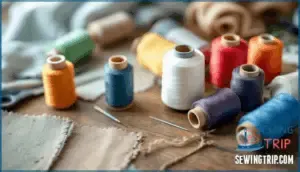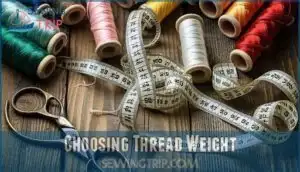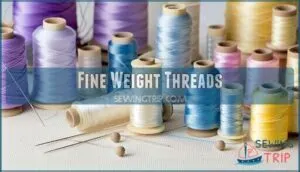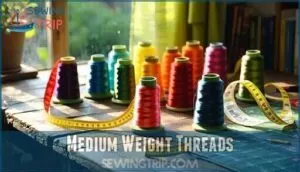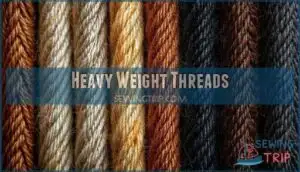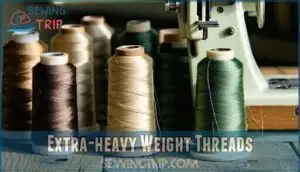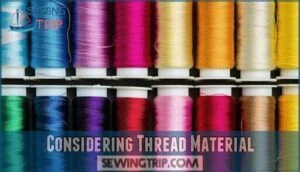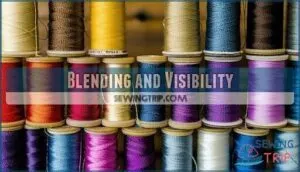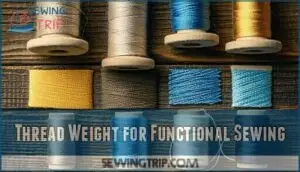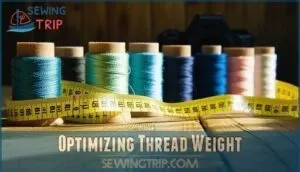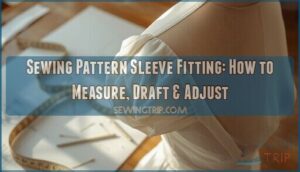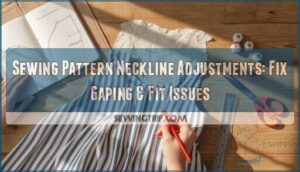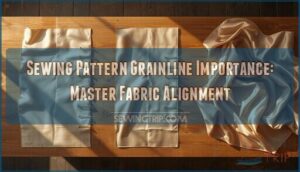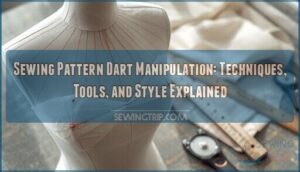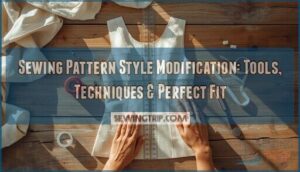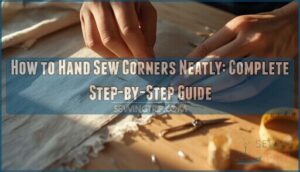This site is supported by our readers. We may earn a commission, at no cost to you, if you purchase through links.
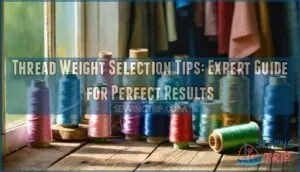
Match fine threads (50-80 weight) to delicate fabrics like silk and chiffon, medium threads (30-40 weight) to everyday cottons and linens, and heavy threads (12-20 weight) to denim and canvas.
You’ll want to take into account your fabric’s weight, the seam’s purpose, and whether you’re doing decorative or functional stitching.
Cotton threads work for most projects, while polyester offers extra strength and polyester-cotton blends provide versatility.
The secret lies in understanding how different weights affect both appearance and durability.
Table Of Contents
Key Takeaways
- Match thread weight to fabric thickness – Use fine threads (50-80 weight) for delicate fabrics like silk, medium threads (30-40 weight) for everyday cottons, and heavy threads (12-20 weight) for denim and canvas to prevent puckering and ensure proper seam strength.
- Consider your project’s purpose – Choose thread based on whether you’re doing functional construction sewing that needs durability or decorative stitching that requires visibility and visual impact.
- Select appropriate thread materials – Cotton works for most projects, polyester offers extra strength for high-stress seams, and polyester-cotton blends provide versatility across different fabric types.
- Test before committing – Always test your thread weight selection on fabric scraps to check tension, stitch quality, and appearance before starting your main project to avoid costly mistakes.
Thread Weight Basics
Thread weight determines how thick or thin your thread appears and affects both the strength and visibility of your stitches.
Understanding thread weight helps you choose the right thread for each project, ensuring professional results whether you’re working with delicate silk or heavy canvas, which is crucial for achieving professional results.
Definition of Thread Weight
Thread weight defines how thick or thin your sewing thread is, directly impacting your project’s strength and appearance.
Understanding thread thickness helps you select the right weight for each task. The denier system and tex system provide weight standards for thread numbering, though most sewers use simple numerical classifications.
Higher numbers indicate finer threads, while lower numbers mean heavier threads. Thread weight selection becomes essential when matching thread to fabric and purpose.
This thread weight definition forms the foundation for making informed choices in your sewing projects. For instance, a higher number indicates a finer thread, such as a 50-weight thread.
Thread Weight Measurement
Understanding how to measure thread weight correctly is like having the right ruler for the job.
Thread weight measurement follows specific Weight Standards, with the most common being the inverse system where higher numbers indicate finer threads.
The Denier System and Tex System offer alternative approaches, while Measurement Tools help guarantee accuracy.
Metric Conversion becomes essential when working with international thread weight guides, making proper thread weight selection and thread weight applications more precise across different sewing projects.
Importance of Thread Weight Selection
Choosing the right thread weight isn’t just about preference—it directly impacts your project’s success.
Wrong selections lead to puckered seams, broken threads, and frustrated sewers.
Thread weight selection affects project durability, stitch quality, and fabric compatibility.
Proper choices guarantee tension balance and aesthetic appeal, transforming amateur work into professional results that last.
Choosing Thread Weight
Choosing the right thread weight can make or break your sewing project, affecting everything from seam strength to visual appeal.
You’ll need to take into account your fabric type, intended use, and desired appearance to select thread that performs perfectly for your specific task.
Factors Affecting Thread Weight Choice
Several key factors determine your thread weight selection success.
Success hinges on matching thread weight to your fabric and project needs perfectly.
Fabric type influences thread compatibility—delicate silks need fine threads while heavy denim requires robust options.
Stitch density affects visibility and bulk, with dense quilting benefiting from lighter weights.
Machine type capabilities limit available choices, as some can’t handle extreme weights.
Project goals drive decisions between strength-focused construction versus decorative emphasis.
Your desired look—subtle blending or bold contrast—guides final thread weight considerations for ideal results, considering the overall thread compatibility and project goals.
Thread Weight for Different Fabrics
When selecting thread weight for your sewing projects, fabric thickness determines your choice.
Heavy fabrics like denim demand robust threads, while delicate silks require fine options.
Material compatibility guarantees proper stitch density and seam strength.
Here’s your fabric-thread pairing guide:
- Lightweight fabrics (chiffon, organza): Use 60-100 weight threads for invisible seams
- Medium-weight materials (cotton, linen): Choose 40-50 weight for balanced durability
- Heavy fabrics (canvas, upholstery): Select 12-30 weight threads for maximum strength
Thread weight guidelines prevent puckering and guarantee needle size compatibility across fabric types.
Consider how thread weight measurement affects your project.
Thread Weight for Various Sewing Tasks
Your project’s demands dictate thread weight selection for ideal Fabric Compatibility and Project Durability.
Construction requires medium-weight sewing thread (40-50wt) for strength without bulk, while decorative topstitching benefits from heavier thread thickness for Stitch Visibility.
Fine threads excel in detailed work like appliqué, ensuring seamless results.
For embroidery, understanding embroidery thread weights is essential for achieving the desired effect.
Task Prioritization guides your thread weight selection—choose strength for structural seams, visibility for Decorative Accents in your sewing project.
Thread Weight Types
Thread weight types range from ultra-fine to extra-heavy, each serving specific sewing needs. You’ll find four main categories that determine how your stitches look and perform in different projects.
Fine Weight Threads
Fine weight threads ranging from 60wt to 80wt excel in micro quilting and detailed embroidery where precision matters most.
You’ll find their blending properties create smoother seams on delicate fabrics without adding bulk.
DecoBob 80wt cottonized polyester stands out for appliqué projects, offering exceptional strength while maintaining invisibility.
These threads reduce puckering substantially compared to heavier alternatives.
You can explore available thread options to find the perfect match for your project with exceptional strength.
Medium Weight Threads
Medium weight threads from 40wt to 50wt offer versatility applications across most sewing projects.
These workhorse threads balance strength with ease, making thread weight selection straightforward for beginners and experts alike.
- General garment construction maintaining even tension settings
- Quilting piecing with excellent stitch appearance
- Topstitching providing crisp definition on woven fabrics
- Machine embroidery delivering project durability without bulk
Material blends like cotton-polyester combine natural feel with synthetic strength, perfect for medium weight threads in everyday sewing.
You can find a variety of options online.
Heavy Weight Threads
Heavy weight threads ranging from 12wt to 30wt pack serious punch for demanding projects.
You’ll find these workhorses excel in upholstery applications, leather stitching, and creating bold decorative accents.
Their robust thread characteristics handle industrial sewing tasks while maintaining durability for outdoor gear construction, requiring larger needles for best results.
These threads are available at heavy weight thread retailers, offering a solution for demanding projects.
Extra-heavy Weight Threads
When you encounter extra-heavy fabrics like sailcloth or multiple denim layers, extra-heavy weight threads (6wt to 8wt) become your go-to solution.
These industrial-grade threads excel in outdoor gear manufacturing, upholstery repair, and canvas stitching applications.
You’ll need specialized machine settings and larger needles for denim sewing projects requiring maximum durability and visibility.
Thread Selection Tips
You’ll make better sewing decisions when you understand how thread material affects your project’s final appearance and durability.
Matching your thread’s weight and material to your fabric and technique guarantees professional results that won’t disappoint, ensuring a final appearance that meets your expectations.
Considering Thread Material
Your thread material choice affects performance more than you might think.
Cotton threads offer natural breathability and blend seamlessly with cotton fabrics, while polyester threads provide superior strength and durability for high-stress seams.
Silk threads deliver unmatched sheen for decorative work, though they’re pricier.
Rayon threads shine beautifully but lack strength for structural stitching, and Nylon threads resist heat and chemicals, making them perfect for outdoor gear.
Match your thread material to your project’s specific demands for ideal results.
Blending and Visibility
Beyond material choice, understanding how your thread will blend or stand out makes all the difference in your finished piece.
Thread color matching determines whether stitches disappear seamlessly into fabric texture or create deliberate contrast.
Consider these visibility factors:
- Sheen level affects light reflection and thread prominence
- Stitch density influences how much thread color shows through
- Thread weight impacts both strength and visual presence.
Your thread selection should align with your project goals—invisible repairs need perfect color matches, while decorative work benefits from strategic contrast.
Thread Weight for Decorative Stitching
Smart embroidery thread choices transform your decorative stitching from ordinary to extraordinary.
Heavier weights like 12wt create bold, dimensional texture effects, while lighter 40wt threads deliver delicate details.
Your stitch visibility depends on weight selection—thick threads dominate patterns, thin ones blend subtly.
Decorative materials require testing different weights for ideal color blending and professional results.
For example, understanding thread weight can improve project outcomes, leading to more professional and visually appealing embroidery work with the right thread weight selection.
Thread Weight for Functional Sewing
Functional sewing demands unwavering seam strength and fabric compatibility.
You’ll need medium-weight threads (30-50) for construction tasks, ensuring proper stitch density without compromising tension adjustments.
Your project durability hinges on thread weight selection—heavier fabrics require stronger threads, while delicate materials need finer options.
Master thread weight importance by matching thread characteristics to your sewing machine’s capabilities and fabric requirements.
Optimizing Thread Weight
You’ll achieve ideal results when you match thread weight to your project’s specific needs and balance strength requirements with visual impact.
Selecting the right weight prevents common issues like thread breakage, poor stitch quality, and unprofessional-looking seams that can compromise your finished work, ultimately affecting the overall quality.
Balancing Strength and Visibility
Finding the sweet spot between thread strength and thread visibility requires careful consideration of your project requirements.
You’ll need to evaluate fabric thickness, stitch density, and thread material when making thread weight selection decisions.
Lighter thread weight offers subtlety but sacrifices durability, while heavier options provide strength with increased visibility.
Color contrast affects how prominently your stitching appears, so match thread weight tips to your desired outcome for ideal results.
Thread Weight for Specific Sewing Projects
Matching thread weight to your sewing project guarantees the best results. Use 50wt thread for quilting projects and garment construction to achieve balanced seams.
Choose 30-40wt upholstery thread for furniture repairs and heavy fabrics. Leather sewing demands extra-heavy threads like 12wt for durability.
Outdoor gear requires robust thread weight classification to withstand harsh conditions and frequent use.
Avoiding Common Thread Weight Mistakes
Don’t use heavy thread weight on delicate fabrics—you’ll create puckering and damage.
Matching thread weight to fabric weight prevents tension issues and guarantees proper needle size compatibility.
Poor thread quality causes breakage, while ignoring project requirements leads to visible stitching when you want invisibility.
Understanding thread weight choices and considering project requirements prevents these costly mistakes.
Ensuring Professional and Durable Results
Professional results consistently emerge when you match thread weight to fabric compatibility and project requirements.
Choose appropriate thread weight for ideal seam integrity and stitch quality. Adjust machine tension according to thread recommendations to prevent puckering or loose stitches.
Your thread choice directly impacts long-term durability, making thread weight knowledge essential for lasting construction. Understanding thread weight measurement is vital for sewing success.
Frequently Asked Questions (FAQs)
How do I choose thread weight?
Like choosing armor for medieval knights, you’ll select thread weight based on your fabric’s needs.
Use fine threads (60-100) for delicate materials, medium (30-50) for general sewing, and heavy (12-30) for tough projects requiring strength.
Is 40 or 50 weight thread heavier?
40 weight thread is heavier than 50 weight thread. In thread numbering, lower numbers indicate thicker, heavier threads. You’ll find 40 weight provides more visibility and strength for topstitching and decorative work.
Which is thicker, 40 or 60 weight thread?
40 weight thread is thicker than 60 weight thread. In thread numbering, lower numbers indicate thicker threads, so 40 weight has more substance and visibility than 60 weight for your sewing projects.
What is the best weight for all purpose thread?
Picture yourself threading a needle with confidence – that’s exactly what you’ll get with 40-50 weight thread.
This versatile workhorse handles construction, quilting, and everyday repairs beautifully, making it your go-to choice for most sewing projects, providing you with the ability to work with confidence.
Can different thread weights damage sewing machines?
Using extremely heavy threads can stress your machine’s motor and tension system, while very fine threads may cause skipped stitches or breakage.
Stick to your machine’s recommended thread weight range for ideal performance.
How do I store various thread weights properly?
Don’t put all your eggs in one basket—store thread upright in containers away from sunlight and moisture.
Keep fine threads (60-100wt) in sealed boxes, medium weights (30-50wt) on racks, and heavy threads (12-30wt) in drawers to prevent tangling, especially to avoid issues with tangling.
What happens when mixing thread weights incorrectly?
Mixing thread weights incorrectly creates tension imbalances, causing puckered seams, skipped stitches, and thread breakage.
You’ll struggle with uneven stitch formation, poor seam quality, and potential fabric damage that ruins your project’s professional appearance.
Do thread weights affect needle selection requirements?
Yes, thread weights directly affect needle selection.
Heavier threads require larger needle sizes to accommodate their thickness, while fine threads work best with smaller needles to prevent fabric damage and guarantee smooth stitching.
Finer threads work best with smaller needles.
Can thread weight cause fabric puckering problems?
Thread weight mismatches can definitely create puckering issues.
When you use thread that’s too heavy for delicate fabrics, it’ll pull and distort the weave, creating unsightly wrinkles and tension problems you’ll struggle to iron out.
Conclusion
Mastering thread weight selection tips resembles building a house—you need the right foundation for every layer to hold.
When you understand how thread weights interact with different fabrics and sewing techniques, you’ll achieve professional results consistently.
Remember that fine threads create invisible seams on delicate materials, while heavy threads provide necessary strength for utility projects.
Choose wisely based on your fabric weight, intended use, and desired finish for lasting success.
- https://docs.google.com/forms/d/1GAQr3Kn1cURCVHUA82hAga1Wv8DCH0IuqDLRUrOpN7M/viewform?ts=63f4f653&entry.1515682415=https://www.merriam-webster.com/dictionary%2Fthread
- https://premium.britannica.com/mw-unabridged/?utm_source=mw&utm_medium=inline-def&utm_campaign=evergreen
- http://eepurl.com/gXvdPn
- https://lorikennedyquilts.com/
- https://www.printful.com/glossary/thread-weight

